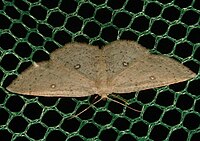Cyclophora albipunctata
| Cyclophora albipunctata | |
|---|---|

| |
| Female | |

| |
| Male | |
| Scientific classification | |
| Kingdom: | |
| Phylum: | |
| Subphylum: | |
| Class: | |
| Order: | |
| Family: | |
| Genus: | |
| Species: | C. albipunctata
|
| Binomial name | |
| Cyclophora albipunctata | |
| Synonyms | |
| |
Cyclophora albipunctata, the birch mocha, is a moth of the family Geometridae. It is found in the Palearctic The southern boundary runs westward along the French Atlantic coast and to the British Isles and North of the Alps. In the East, the species range to the Pacific Ocean (Russian Far East). South of the North Alps line it is found in some higher elevation areas and mountains.In the Pyrenees, the Massif Central, the Southern Alps, the Northern Dinaric Alps, in the Western and Northern Carpathians, in northern Turkey and the Caucasus. In the North, the range extends up to the Arctic circle. In the far East the nominate is replaced by subspecies albipunctata griseolata Staudinger, 1897.

The wingspan is 20–25 mm.The apex of the front wing is slightly pointed. The ground colour is usually white, whitish-grey to light brown. Some specimens are over dusted reddish.The pattern is very variable. Interior and exterior cross line are almost always in a series of point series or may be almost extinguished. Slight points are usually found on the costa: the costa can be over dusted dark in the basal half. A median band can be quite clearly present but also virtually absent. Margin stains are almost always developed, significant and mostly flowing into each other, slightly darker in the margin field. The discal spots are developed as a dark, white centred rings. These can be also slightly elliptical, or be reduced to simple, slightly reddish stains. The discal spots of the forewings are often bordered brown-red but if present, the discal spots of the hind wings are, however, mostly black.
The larvae feed on Betula species, including Betula verrucosa, Betula pubescens, Betula nana and Betula pendula.
Subspecies
- Cyclophora albipunctata albipunctata (Europe, Turkey, Transcaucasia, western Siberia to Mongolia)
- Cyclophora albipunctata griseolata (Staudinger, 1897) (south-eastern Siberia, Amur, Korea, Japan)
References
- ^ "Home of Ichneumonoidea". Taxapad. Dicky Sick Ki Yu. 1997–2012. Retrieved 2013.
{{cite web}}: Check date values in:|accessdate=(help)
External links
- European Butterflies and Moths
- Lepidoptera of Belgium
- UK Moths
- Vlindernet Template:Nl
- waarneming.nl Template:Nl
